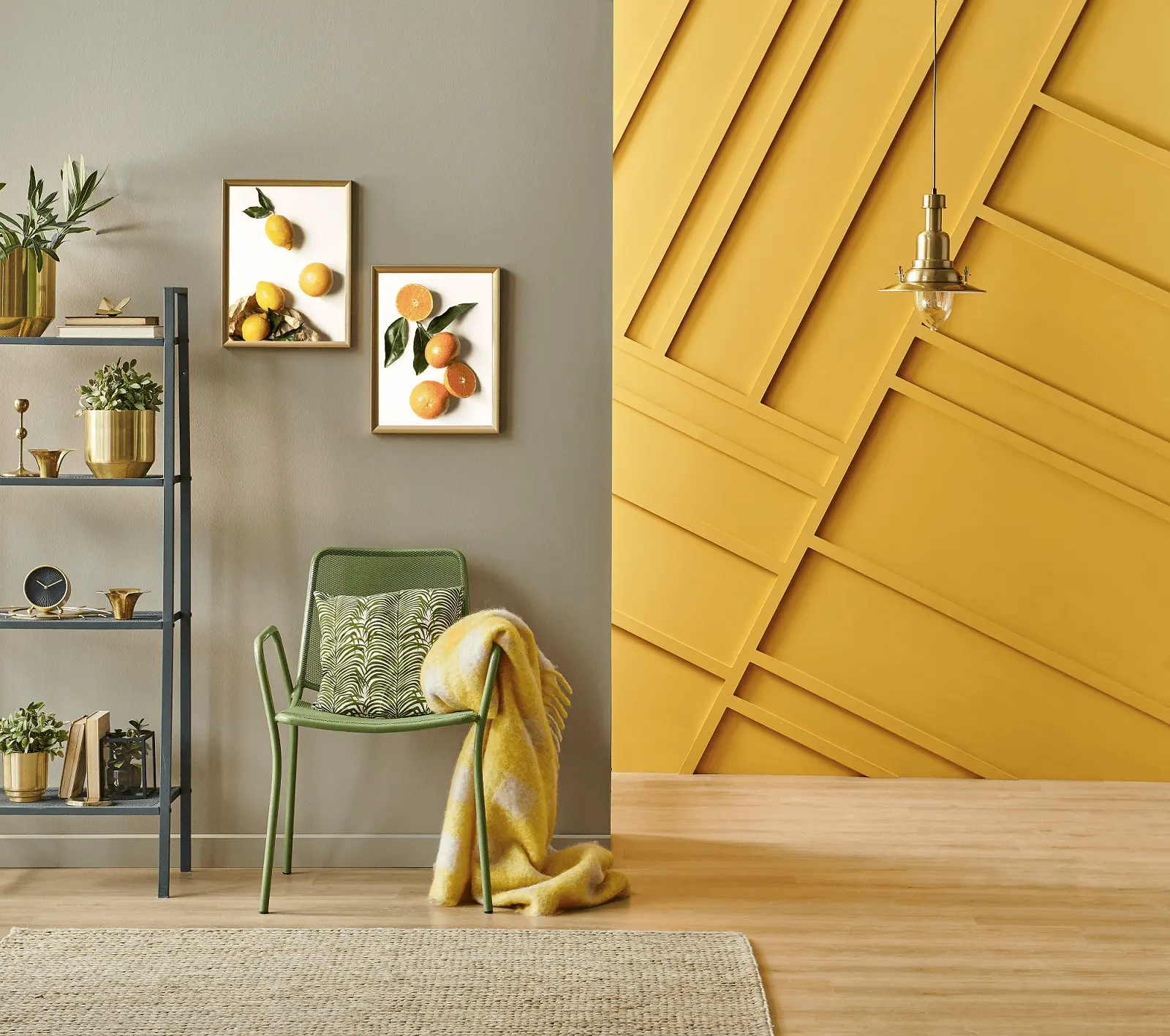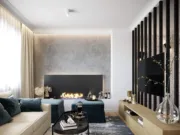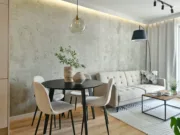What instead of lamellas for the wall?
What to create on a wall instead of lamellas? Innovative ideas include: upholstered panels, acoustic panels, architectural concrete, brick, stone veneer or English paneling, as well as many other constantly emerging arrangements. Each of these options adds character and elegance to the interior, creating a unique atmosphere. Our guide will show you how to bring these inspirations into modern interiors!

What will you learn from this article?
- How to arrange upholstered wall panels?
- Can acoustic panels be a decorative wall feature?
- How to place architectural concrete to make it the focal point of interior design?
- How to use the timelessness of brick in wall design?
- Does English wainscoting fit only in retro-style interiors?
- Summary – what instead of lamellas on the wall?
How to arrange upholstered wall panels?
Upholstered wall panels are an excellent way to add elegance and coziness to an interior. They come in a variety of colors and textures, allowing you to create unique compositions. They are ideal for: living rooms, bedrooms and offices, giving them a luxurious character. They perfectly harmonize with natural materials, such as wood or stone, which further emphasizes their aesthetic value.
Upholstered panels and other materials
For an elegant look, upholstered panels can be combined with other wall coverings, such as decorative concrete or stone veneer. This combination will add character and depth to the interior, creating a modern interior design. In minimalist interiors, these panels bring warmth as well as coziness, especially when juxtaposed with raw architectural concrete.
Stylish interiors with upholstered panels

Upholstered panels work well in a variety of interior styles, from classic to modern. In traditional arrangements they can be combined with English paneling, and in modern interiors with 3D panels. They are a practical solution in children’s rooms, where they can act as a headrest, protecting the wall from mechanical damage.
Examples of arrangements
In the living room, upholstered panels can be used on one wall, creating a striking focal point. Their installation in geometric patterns adds a modern touch to the interior.
In the bedroom, these panels can act as a headrest, creating a cozy place to relax. Their color and texture should harmonize with other elements of the interior, such as wood panels or tiles imitating concrete.
Upholstered wall panels are an excellent choice if you’re looking for an alternative to traditional fins. They can add elegance and coziness to any room, making it uniquely stylish.
See more inspiration on our Instagram!
Mardom Decor’s InstagramElements from Mardom Decor that you will use for this arrangement
When arranging an interior with upholstered panels, it will be useful:
- Skirting boards: Premium skirting board QL007P, Premium skirting board MD094P, Premium skirting board MD355P,
- Ceiling mouldings: Ceiling molding MDB132, Ceiling molding MD145, Ceiling molding MD118,
- Lighting strips: Lighting strip MD118, Lighting strip MD161, Lighting strip QL002.
Can acoustic panels be a decorative wall feature?
Of course – acoustic panels can successfully serve a decorative function on the wall. Using them as a design element is a great way to combine functionality with aesthetics. Acoustic panels can be placed in a variety of compositions, creating unique patterns and dynamic structures on the walls.
One possibility is to arrange the panels in geometric patterns, which gives the interior a modern and dynamic character. Such an arrangement will work perfectly in minimalist interiors, where every element has significance. Did you know that as a “wall companion” you can also use upholstered panels in different shades, which will bring warmth and coziness to the room?
Acoustic panels in modern interiors
Acoustic panels also look great in the company of raw materials such as architectural concrete or stone veneer. Thanks to them, the interior gains elegance and sophistication. In the industrial style, the panels can, as an unobtrusive, small addition, emphasize the rawness and simplicity of the space, blending perfectly with metal shelves and old boards.
In modern interior design, acoustic panels can be used as the main decorative element on one of the walls, for example, in the living room or bedroom. When installing them on the wall, it is worth paying attention to how they match the rest of the decor, both in terms of color and texture. Acoustic panels are also perfect for children’s rooms, where they can play both a decorative and functional role, improving the acoustics of the room.
In modern interior design, acoustic panels are not only a practical solution, but also an element that adds elegance and character to the space. Their installation is relatively simple, and the end result is sure to delight any design lover.
Elements from Mardom Decor that you will use for this arrangement
Arranging a space with acoustic panels will help:
- Karnisze: Zestaw karniszy D100 z zaczepem, Zestaw karniszy S100, Zestaw karniszy S150,
- Ościeżnice: MD359E ościeżnica, MD008E ościeżnica, MD258E ościeżnica.
How to place architectural concrete to make it the focal point of interior design?
Architectural concrete can become a focal point of interior design, especially when placed on one wall in the living room. Such an accent is eye-catching and creates a striking contrast with warm wood tones or stone veneer. In minimalist interiors, decorative concrete goes well with raw materials such as steel and glass, emphasizing their modern character. It’s also worth experimenting with installing concrete panels all over the wall, creating a cohesive background for exposed decorative elements, such as metal shelving or designer lighting.
Architectural concrete styling
Architectural concrete is a material that works well in various interior design styles. In industrial style, it can be juxtaposed with metal shelving and raw materials, emphasizing its factory character. In minimalist interiors, decorative concrete goes well with wood, adding warmth and coziness.
It is also worth considering combining concrete with imitation concrete tiles, creating a unified, modern surface. A concrete wall in the living room can become the focal point of the interior, drawing the eye and giving the space elegance.
Practical tips
Note that richly decorated rosettes, columns, half-columns, pilasters and other decorative elements do not go well with decorative concrete or concrete slabs. Too many detailed ornaments can make the walls overly overwhelming with their excess.
A concrete wall in the living room is already a distinctive accent in itself, so it is advisable to avoid excessive details. Moderation and subtlety should be maintained to avoid the effect of overkill and arrangement chaos.
How to use the timelessness of brick in wall design?
The timelessness of brick in wall design is a theme that never ceases to delight lovers of interior trends. As a raw material, brick works well in a variety of interior styles, from industrial to rustic. With its natural texture and warm tones, brick can add character to any room.

However, it should not be forgotten that brick in shades of gray will bring to mind austere and restrained design shades, while brick in shades of hot red will slightly emphasize the temperament of the room.
Brick charm – how to bring timeless character to an interior
Brick walls are not only beautiful, but also functional. They can act as wall coverings that bring a unique atmosphere to the interior. When combined with modern elements, such as wall mouldings or wall panels, brick gets a fresh new look. Brick walls go well with natural materials, such as wood or architectural concrete, creating a harmonious whole.
Brick is also an excellent choice instead of wall fins, especially in minimalist interiors, where the rawness of the material and simplicity of form are base. You can use gypsum panels that imitate brick, which are lighter and easier to install, but retain the authentic look of brick.
Brick in modern design – a combination of tradition and modernity
For those looking for an alternative to traditional trim, brick offers unique design possibilities. By putting on brick accents in your interior, you can add elegance and coziness to the space. Geometric patterns, decorative panels or old boards accompanied by brick will add character to any room. It is worth remembering that brick, thanks to its durability and resistance to mechanical damage, is an excellent choice for any interior, from the living room to the kitchen or children’s room.
Thanks to the brick, each interior acquires a unique character, combining timeless charm and modern functionality.
How do you arrange the veneer to get a spectacular effect?
Veneer is an extremely versatile material that can transform any interior. For a spectacular effect, it is worth using it as a wall covering, combining it with other materials, such as architectural concrete or MDF.
Veneer, with its natural appearance and warm wood tones, adds coziness and elegance to the interior. You can use a variety of veneer patterns, which work well with traditional wall panels to create unique compositions.
Veneer combinations and applications
One interesting solution is to combine veneer with decorative wall mouldings. In modern interior designs, veneer blends perfectly with raw materials such as drywall or old boards. In minimalist interiors, veneer works well as a wall decoration, especially when combined with wall coverings that imitate concrete.
It is also worth using veneer in a children’s room, where its natural materials and warm wood tones will add a feeling of coziness and security. Veneer is also an excellent choice for the living room, where it can be used as a wall decoration, creating an elegant and modern decor.
Does English wainscoting fit only in retro-style interiors?
English wainscoting is an elegant wooden wall paneling that most often covers the lower part of walls, giving interiors a unique character. It became popular at the beginning of the 20th century, but made its biggest splash in Poland in the 1970s and 1980s. Today, although it is mainly associated with retro style, its timelessness makes it often chosen also for modern arrangements. It works well in the following styles: classic, rustic and even eclectic, adding elegance and warmth to interiors.
The use of English paneling in modern interiors
English wainscoting is not limited to retro style. In modern arrangements, it can be combined with various materials to create a unique effect. When combined with architectural concrete or MDF panels, wainscoting creates an interesting contrast between the rawness and warmth of wood.
You can use it in the kitchen, living room or even in the children’s room, where it will add coziness. In minimalist interiors it goes well with simple forms, as well as muted colors, while in eclectic style it can be juxtaposed with colorful accents and geometric patterns.
See our products on your wall
Not sure how our product will look in your home? Go to our visualizer, which will help you get rid of any doubts.
Go to visualizer
Arrangements with English wainscoting
For a spectacular effect, English paneling can be combined with wallpaper with geometric patterns or imitating old boards. In the living room it will be perfect as a background for stylish furniture and decorative accents. You can also use it in the hallway, adding wall coverings there in the form of wall panels or wooden panels. In the bedroom, English paneling can act as a headboard, giving the interior elegance and class.
However, avoid combining English wainscoting with raw materials that could overwhelm the interior. When you decide to leave the decorative laths on store shelves, then reach for refined stucco, which will give your interior high style, good taste, as well as a unique character! Antique or baroque rosettes are sure to catch the attention of your guests!
Fashionable arrangements with English wainscoting
English wainscoting goes well with natural materials such as wood and brick. In Scandinavian style, it can be paired with light wall colors and minimalist furniture to create a cozy and harmonious interior. In loft style, wainscoting can be combined with raw decorative concrete elements, adding character and depth to the interior. On the other hand, in traditional interiors, English wainscoting adds elegance and class, especially when combined with: classic wall mouldings, rosettes, columns, half-columns, pilasters or cladding.
English wainscoting is a versatile solution that can be adapted to different interior styles, from classic to modern. Its skillful application can significantly enhance the aesthetics of any room.
Elements from Mardom Decor that you will use for this arrangement
When creating an arrangement with English paneling, you can use such elements as:
- Corners: Corner MDD308-12, Corner MDC250-11, Corner MD002-10,
- Rosettes: Rosette QR002, Rosette QR005, Rosette B3023, Rosette B2021, Rosette B3077,
- Columns: Column cap C1000-2W, Column C3000W, Column base C5000-4W,
- Semi-columns: Half-column cap C1000-2H, Half-column C3000H, Half-column base C5000-4H.
Summary – what instead of lamellas on the wall?
Wall laths are not the only option that can add high style and sophistication to any room, as well as optically “level out” minor irregularities. Instead of laths, you can choose natural materials or wall coverings in the form of: architectural concrete, bricks, acoustic panels or veneer imitating, for example, gypsum panels or wood panels. In addition, you can add character and unique style to the interior with English paneling or using 3D panels in the form of: rosettes, columns, half-columns, decorative elements or other small stucco elements. It all depends on your finesse and imagination! Let yourself be carried away by it, creating amazing spaces!




